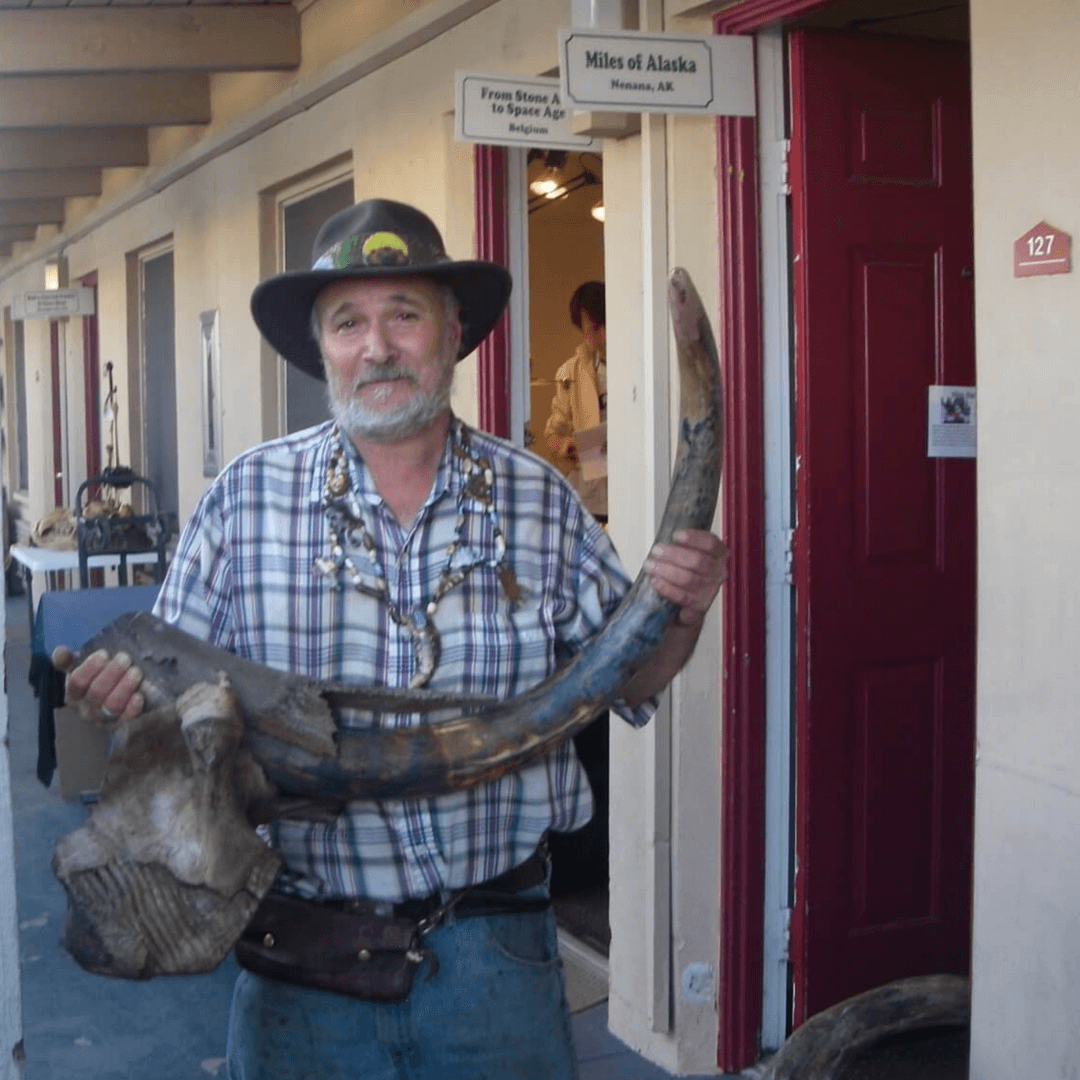Editor’s Note: Miles, a longtime Xpo Press advertiser and good friend, has displayed and sold his handmade art, jewelry, and knives, his books, rocks, fossils, and scrimshaw (the latter Miles he unearths himself in Alaska) in Tucson for over twenty years. He has written twelve books, all available on Amazon, telling his adventure stories of life in the wilderness of Alaska, his home. You can meet Miles and peruse his works at the Tucson Gem & Mineral Showcase each year at the same location, the Fossil & Mineral Alley at Days Inn, Room 127. Learn more about Miles’ company on his Xpo Press profile page, Miles of Alaska. The following personal account was written by Miles exclusively for Xpo Press.
_________________________________________
The first time I set up at a Tucson show was in 2009. I came down from my home in Alaska, and my mother and grandmother came with me for health reasons. I brought my art, fossils, books I wrote, and Alaskan rocks. I soon found out what setting up at a gem show would be like. I only sort of understood selling, wholesale, and consignment.
Back then, I had a personal attachment to a lot of my inventory, but I was fine with selling my stuff if I was able to get big dollars for it, as I was sure I could do. We all hear of the deals, of the big money that’s possible to make in Tucson. I was so hopeful. In Alaska, I did not know anyone who had a lot of what I find. I had one full tusk, some broken bones, and items I usually sold at my local farmers market or church bazaar, where table fees might be $10 to $30. There, if I make $200 it’s a good day to brag about. Much like experiences with garage sales.
Now I’m in the world-famous Tucson. I’m holding my precious box of scraps in my showroom and look up as the Russian fossil dealers began to show up ... with what seemed to me like train cars full of fossil ivory. It was hard for me to imagine there was this much found in the history of the planet! Museums tend to stress how rare their displays are. I was in shock and began to understand that my precious finds were like the sweepings off the floor after the Russians unpack. I had a lot to learn.
All my show costs staggered me. I struggled just to break even selling my first few years doing Tucson shows. I had to first come to terms with “value” from a vendor’s view, from the standpoint of turning my precious finds into a business. Yes, a gem show is about having fun, meeting people, learning, and even getting business tax write-offs. However, this is a serious place where million-dollar deals take place. Few can afford to put their money down just for fun. Most of us take the show seriously and depend on it financially. We can help people out, offer free advice, appraise your find, and steer you in the right direction. But the bottom line of what I am up to needs to be money.
People who come by my room at the show often ask, “So what is this worth?” I may ask with a smile, “Depends if you are selling it or buying it,” partly as a joke. Value depends on quality, of course, but it can also depend on where it came from, provenance, or a story, pictures, or proof of anything. Many finds have legal aspects, like on whose land it was found. It’s nice to have proof of legality and not just your good word. Markets can change due to other new finds, the economy, and new rules. What I pay may have to do with how much more material you have in that box or what I feel the chances are you’ll come back.
As a dealer, I may know more on the subject than you do, but sometimes a customer knows more than the dealer! I tell people, “I’m more the guy in the field who digs and finds, not the scientist who labels and grades.” You don’t ask the guy in the mine who pulls out a raw diamond what it is worth. He’s the first step in the food chain, “the source.” Some items I and other dealers know by having found them ourselves, and only we have the backstory on the find. And it’s possible our story may be wrong about a find! I once had a specimen of woolly rhino leg bone mixed in with my mammoth bones. The bone seemed odd or off, but I assumed it was a young animal or subspecies. Another vendor who is more of an expert than I am on bones pointed out the shortness and thickness of this odd bone. “You got a rare rhino from Alaska,” he rightly surmised. Honestly, this is sometimes how money gets made at a gem show, i.e., another vendor might know more about your product than you do. Thanks to the expert, I raised the price of the rhino bone from $100 to $500.
I buy turquoise. My gift shop tourist market in Alaska is, “If it’s blue, it’s turquoise. If it’s green, it’s jade.” There are fifty grades of turquoise. There are blends of azurite, malachite, turquoise, chrysocolla, chrysoprase, and all are copper-based. Chemically similar. Even experts have opinions on when one grade transitions into another or if it’s a blend. I may call over an expert friend to glance at my tray and point out obvious mistakes. Often, if we know what mine the material came from, we have a baseline for its value. Valuing turquoise is tricky — It may be low grade, it could be a good fake, or it might be enhanced with dye. Just last year a guy revealed to me, “This one tiny rock is worth more than everything else in the tray.” Turquoise is not my specialty, but I acquire it in trades, and I use it in my art. I try to learn and see the differences. It’s always ongoing, even after fifty years in business.
I’m kind of a fang and claw expert and, so, I’m often the go-to guy at my show on this subject. Vendors and good shoppers know who to go see when they’re buying or need advice. Like, I know an older guy who is my go-to when I need opal advice. Who to go to for what items becomes a skill in itself and part of understanding this business.
Long ago, I found a mammoth tusk in Alaska. All of us hobby diggers would sell to one guy. I sold my tusk to him for $2,000 and was so excited. My thought was two grand for three days of work — what a deal! Right after my big sale, while I’m still there, my buyer gets on the phone and sells the tusk I just sold him for $10,000 sight unseen. Then I found out later that the second buyer of my tusk took it to Tucson and got $26,000 for it. That was long ago. I’ve learned a few business lessons the hard way since then.
I will say the Tucson show tends to collect honest, reputable dealers. The show managers have a vested interest in the overall show having a good reputation. Bad business and unhappy customers are not going to be accepted at the show. Most of us keep coming back. We rely on our good reputations. Most of us love what we do and desire to educate and inspire people. If you are excited by your find, we’ll help because we want you to keep coming back. You might find something we want, or we may have something for your collection. If not now, maybe down the road. And it’s always a win-win educating young people, assisting them in becoming future rock and fossil collecting adults.
Visit the Miles of Alaska profile page on Xpo Press for detailed information, including show dates, locations and maps, booth locations, contact information, photos, and website address.




